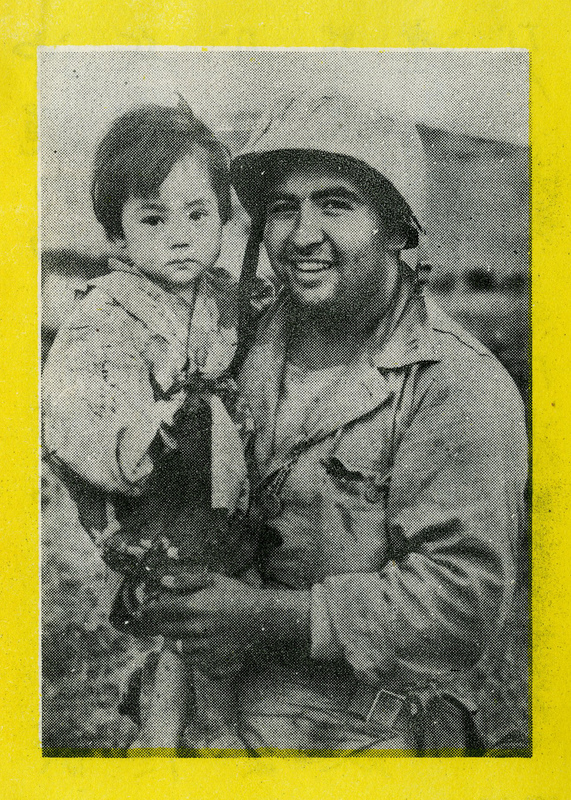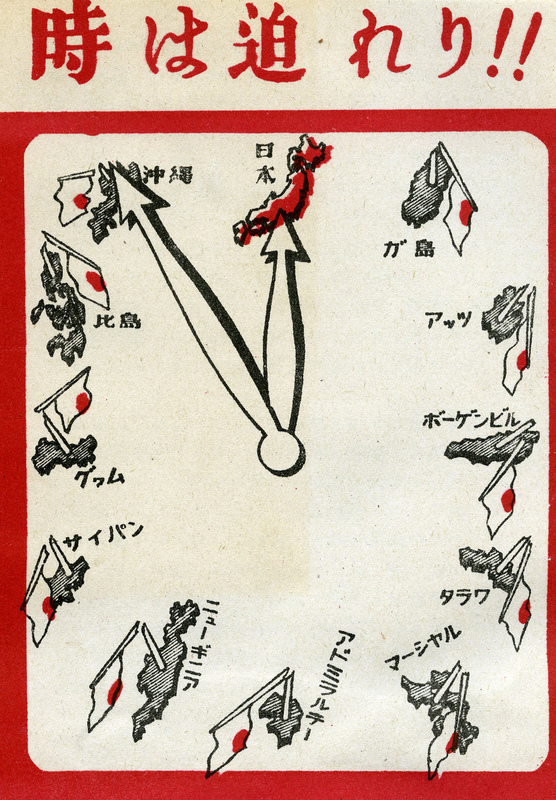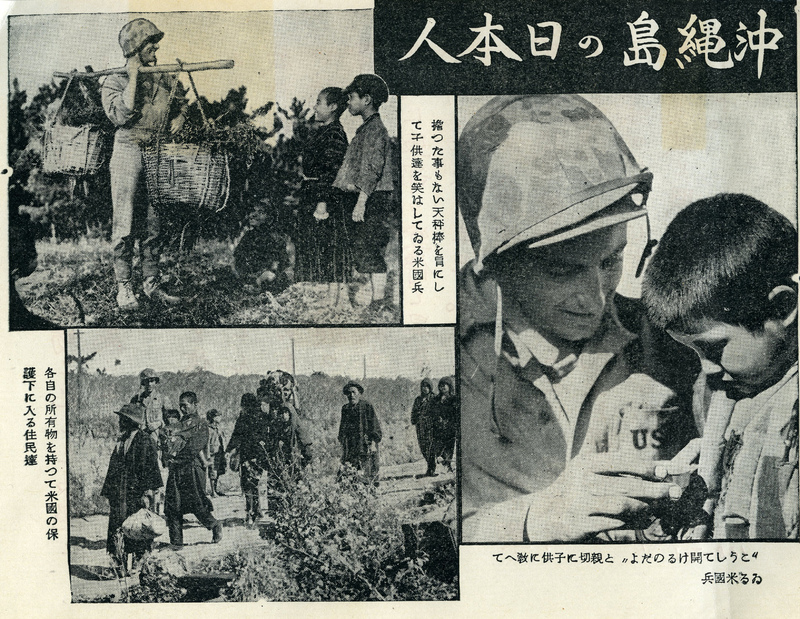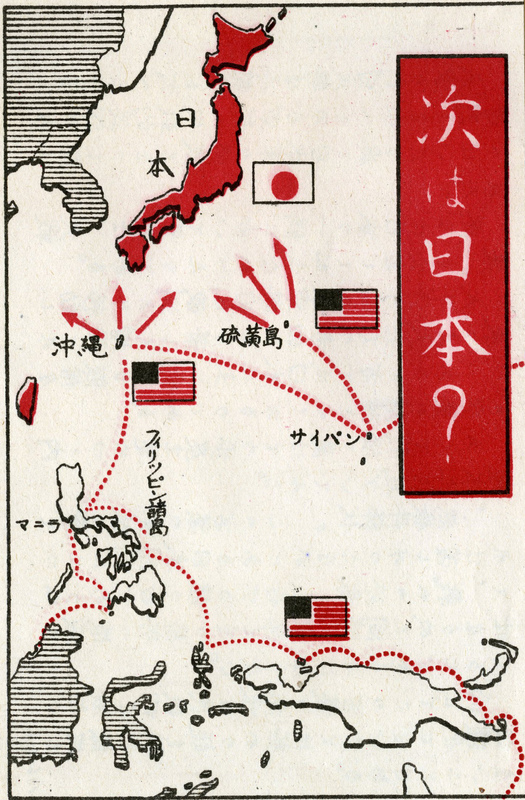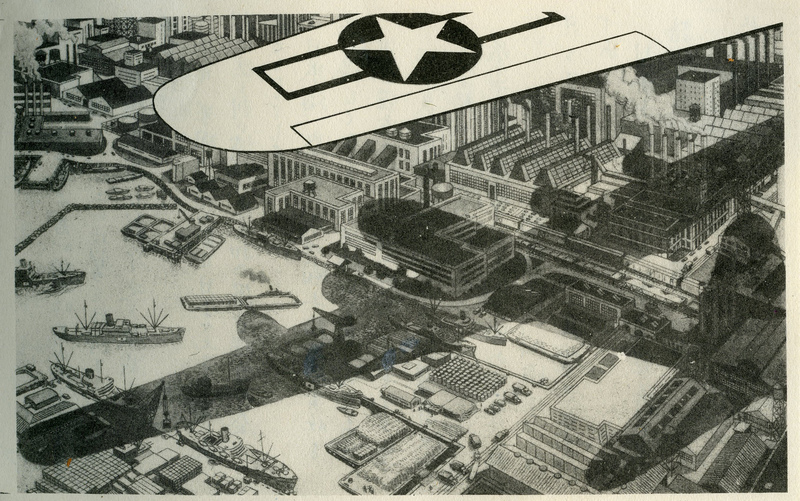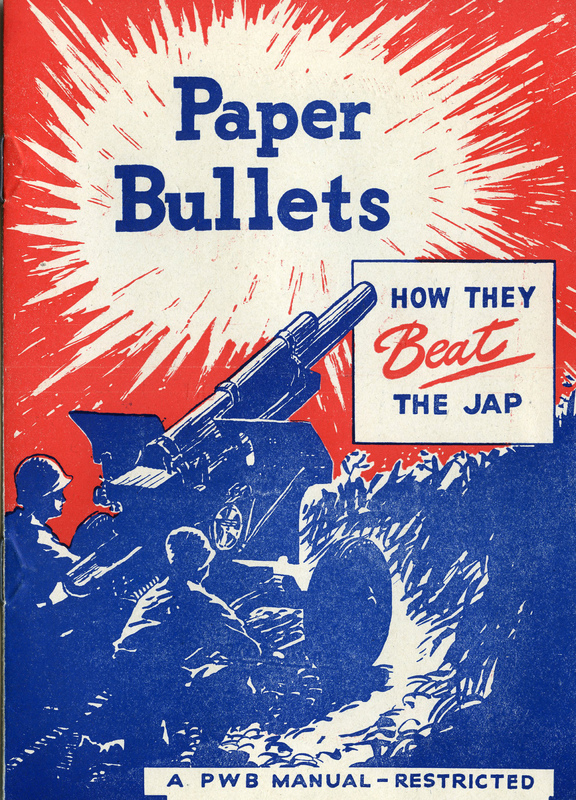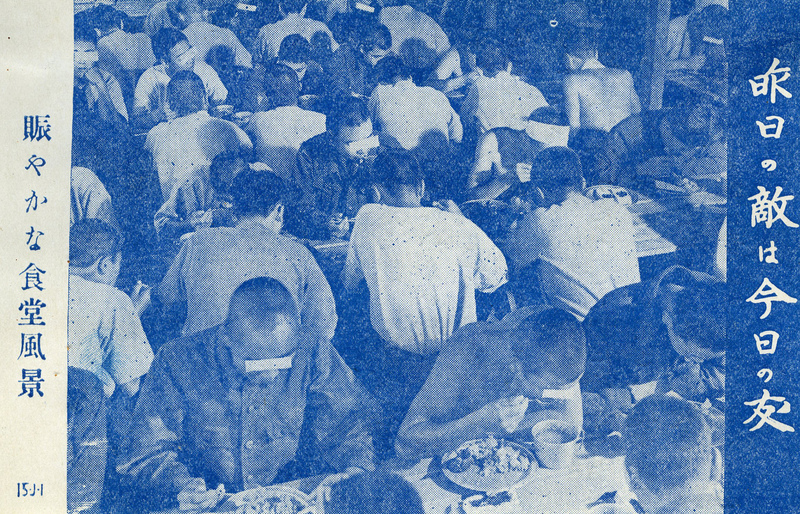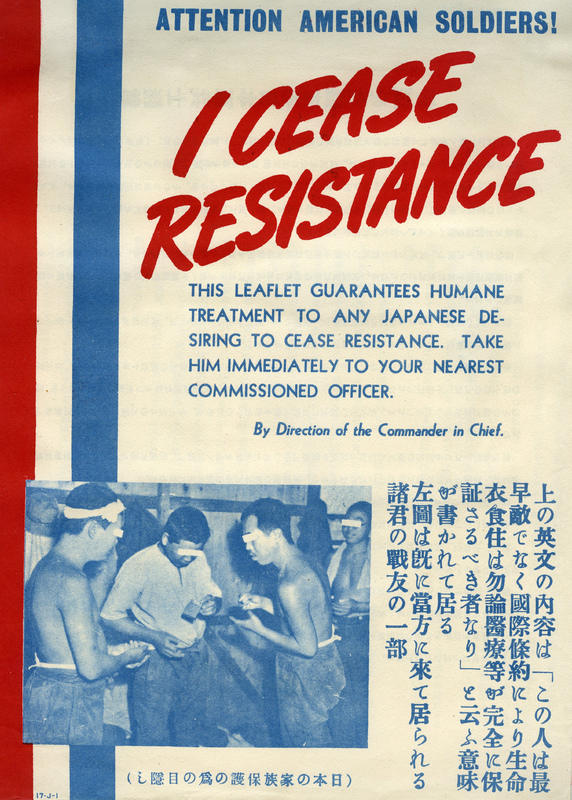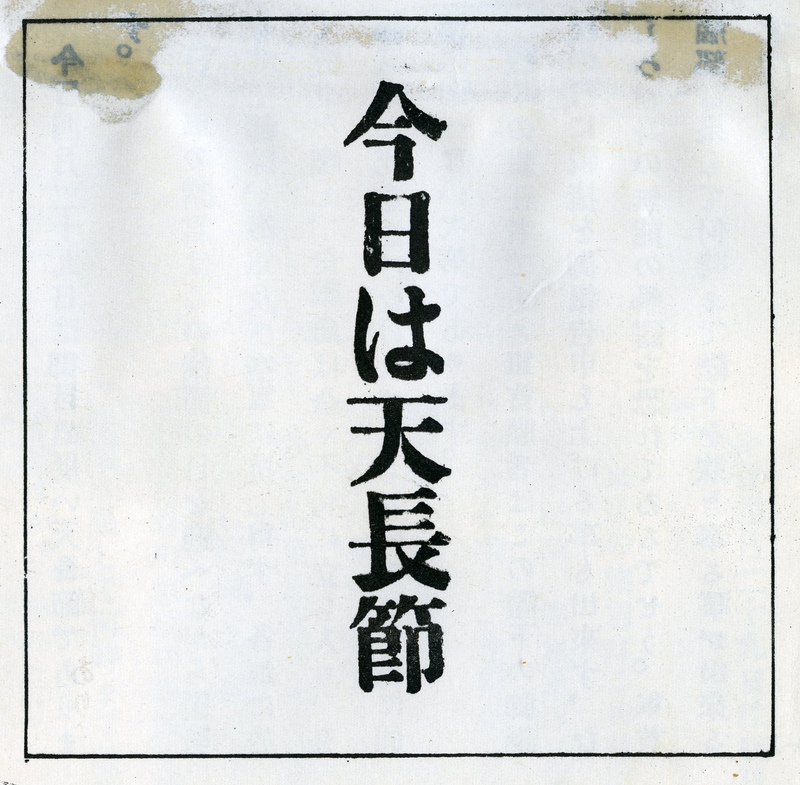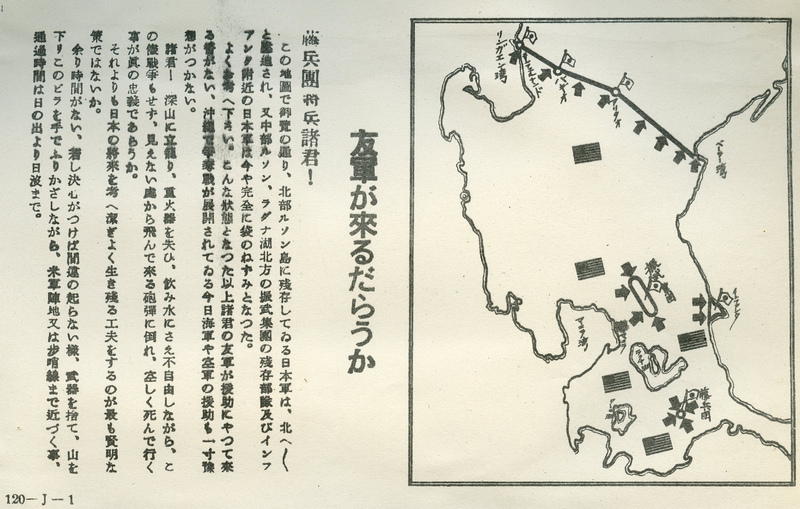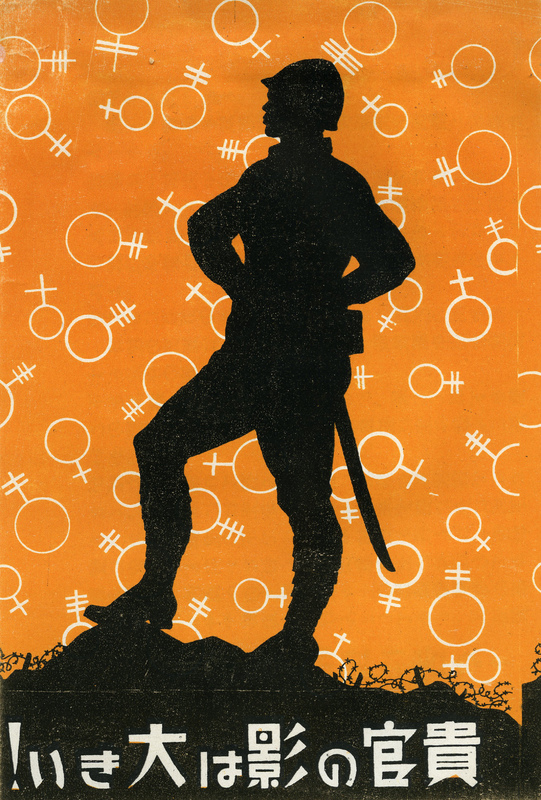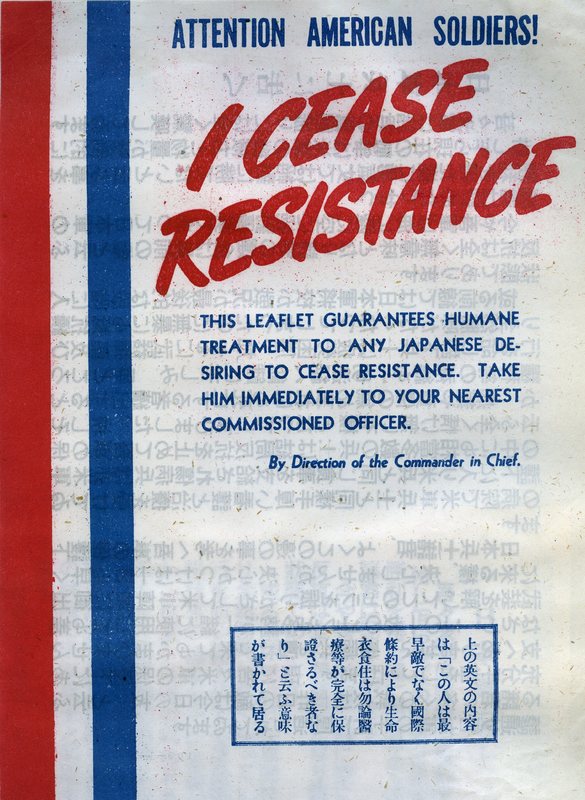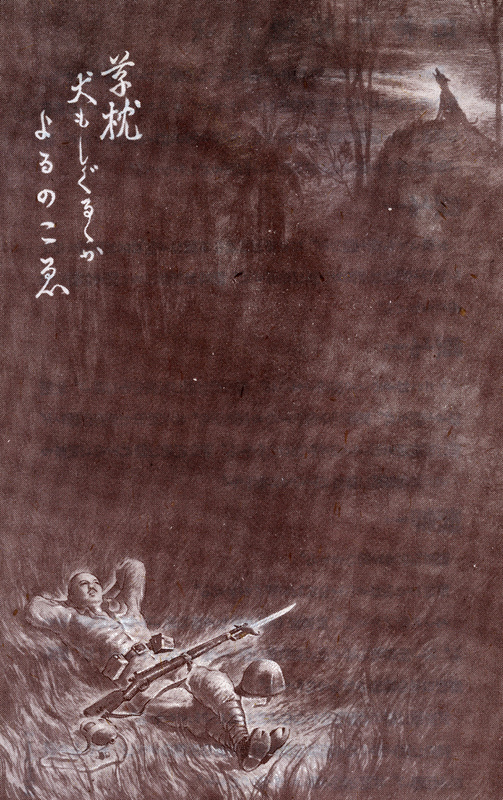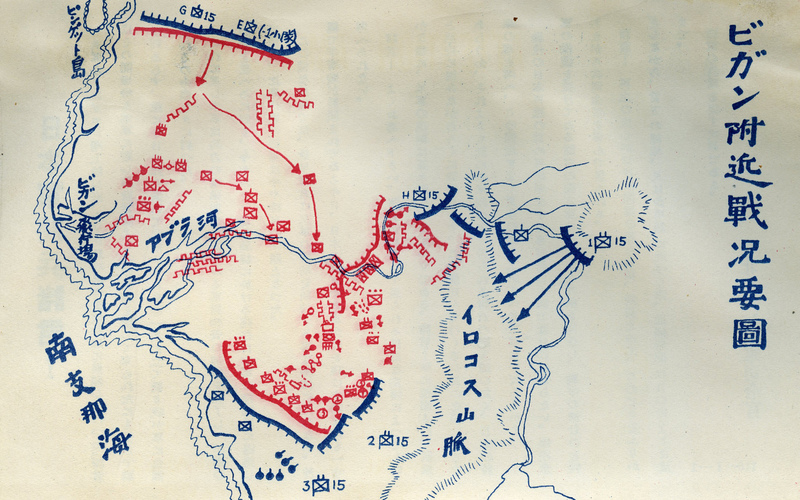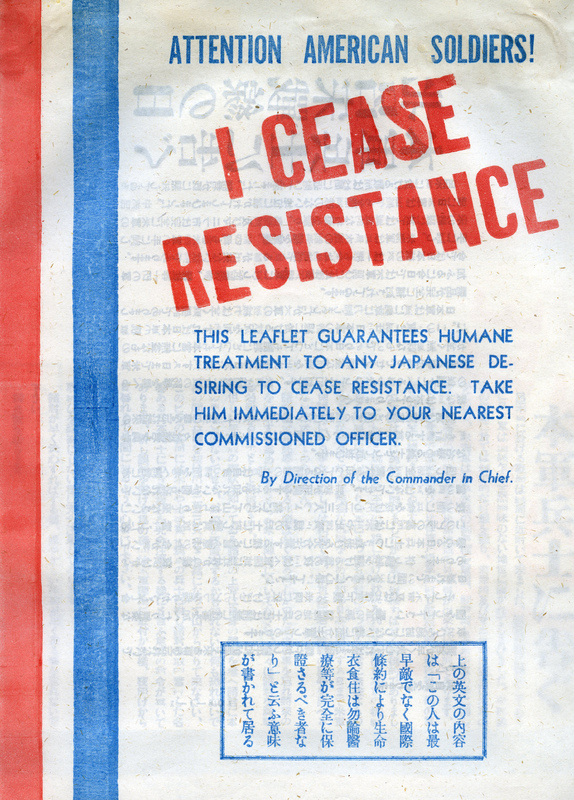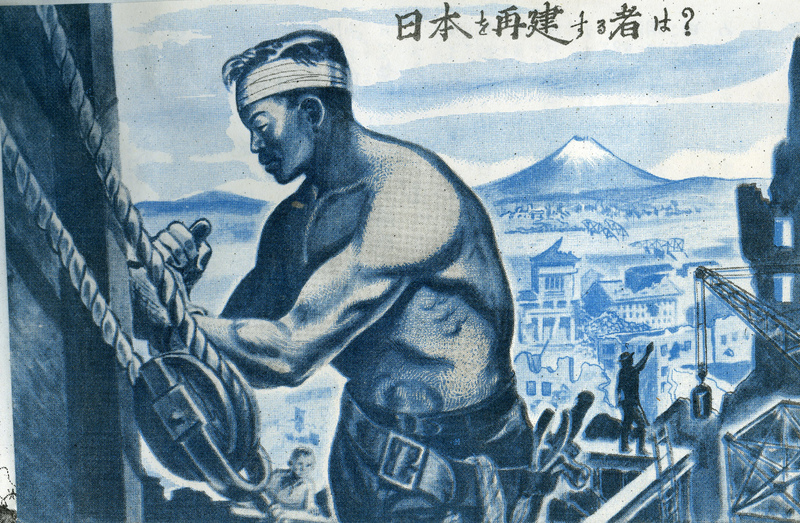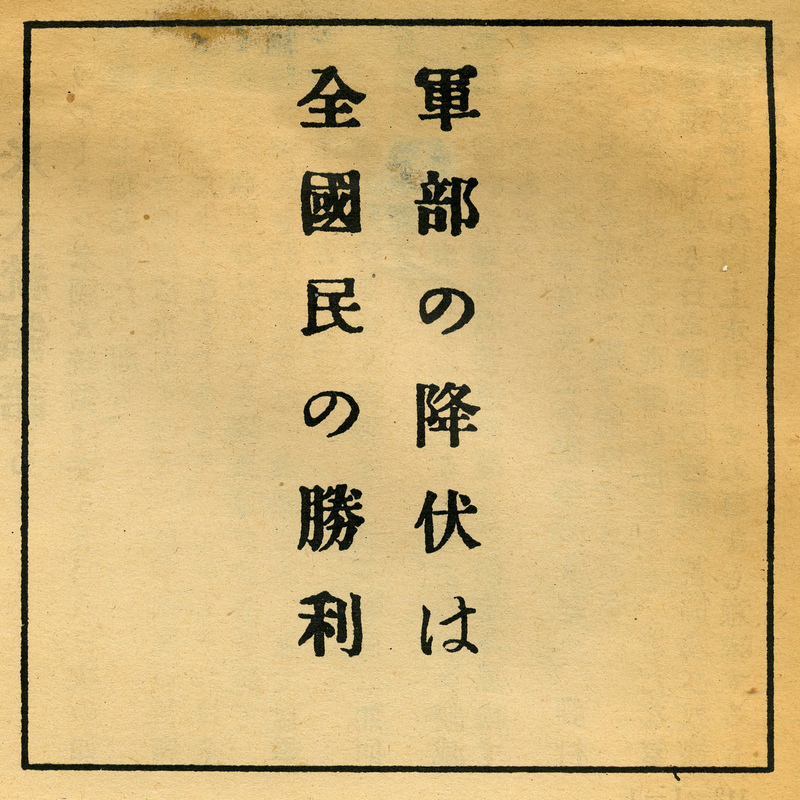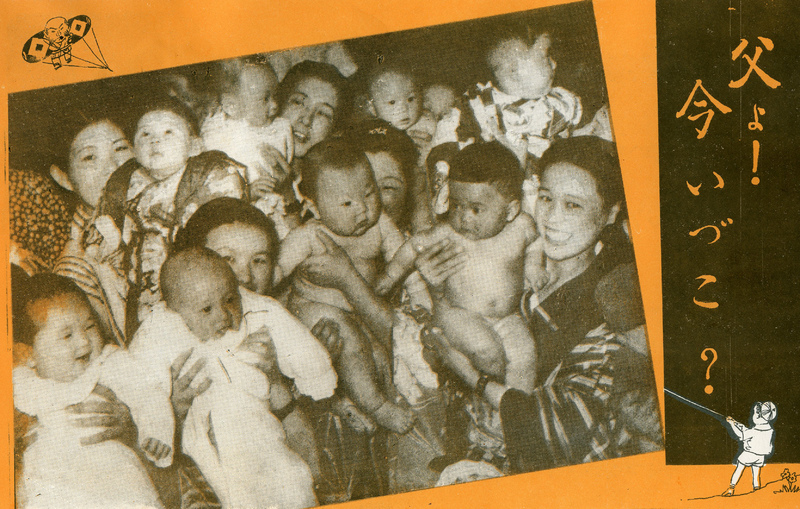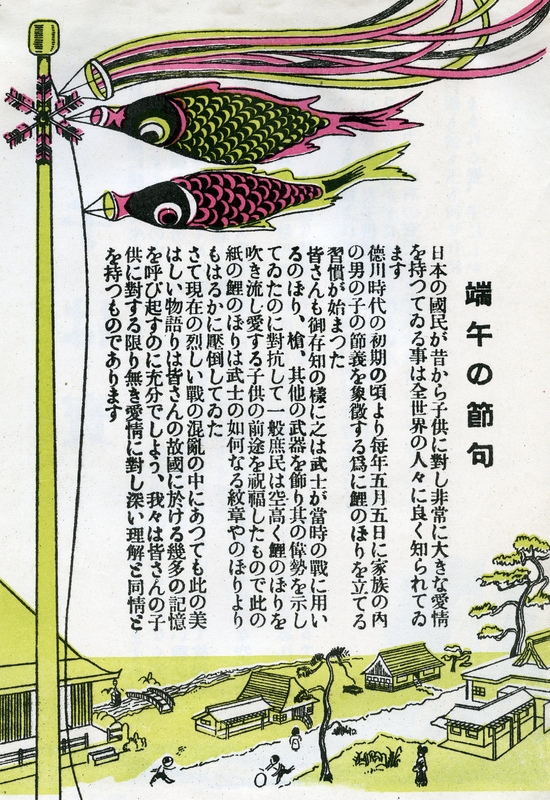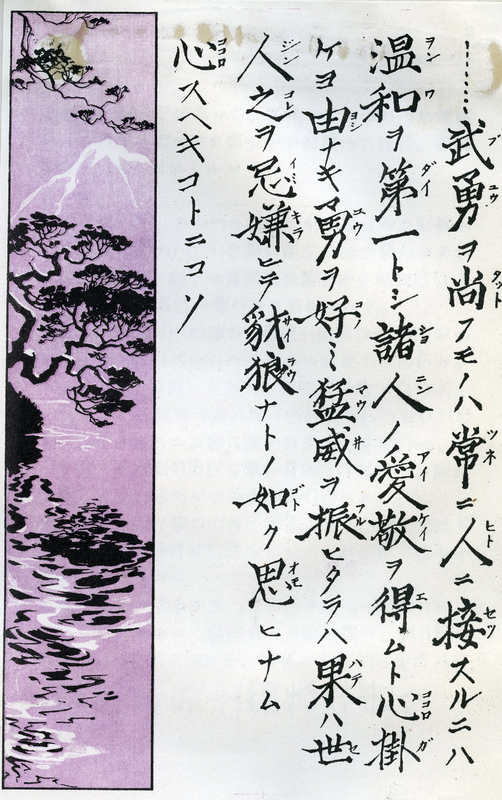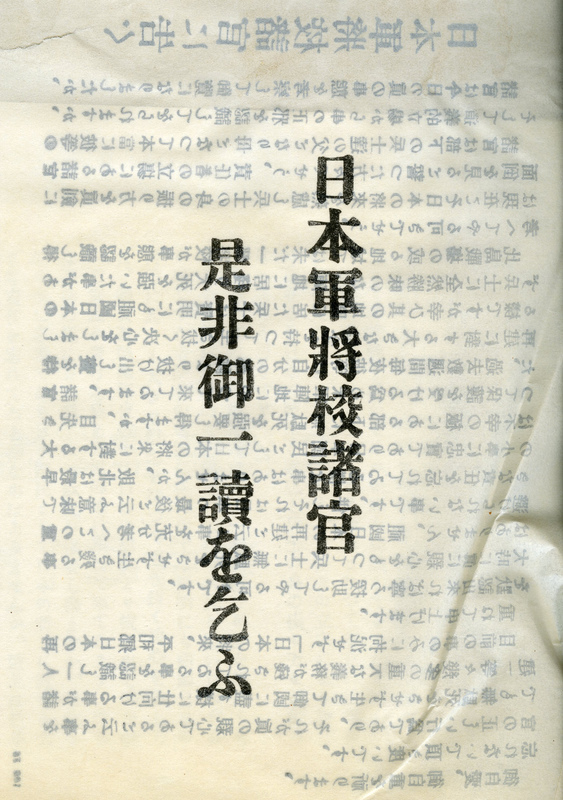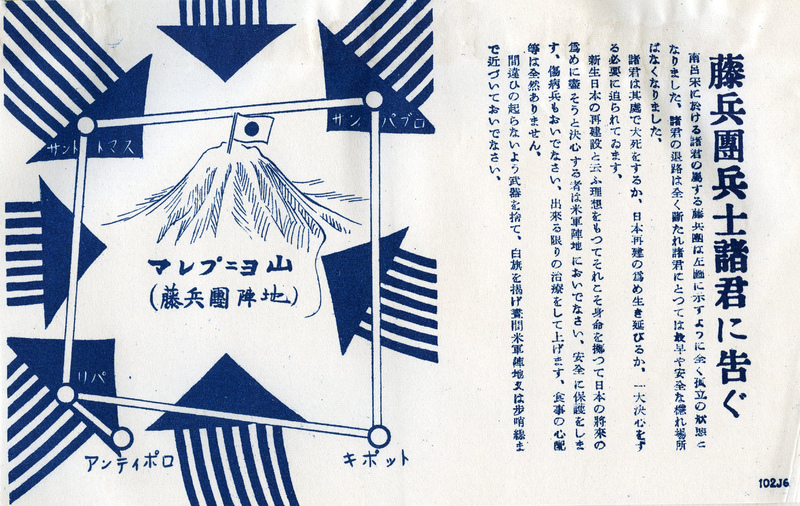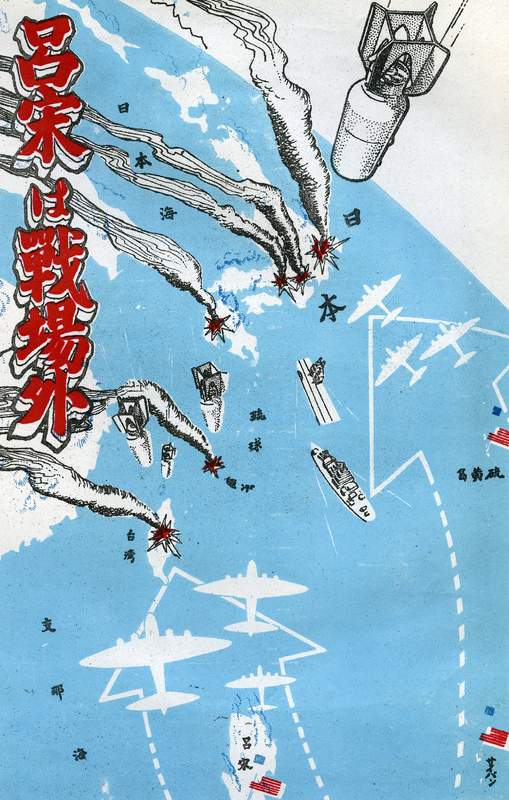WWII Propaganda Leaflets from the Baldwin Scrapbook
- Title
- WWII Propaganda Leaflets from the Baldwin Scrapbook
- Description
- The Psychological Warfare Branch of the United States Armed Forces was a military unit that created and distributed propaganda during the Second World War. The scrapbook contains approximately 200 pieces of their propaganda, mostly in Japanese, that were intended for distribution in the Philippines, Japan, and other nearby areas. Each item is accompanied by a typed translation into English. Pacific University Archives MS.70
Items
-
'Soldier and Child' propaganda leafletA propaganda leaflet issued by the Allied Forces during World War II after the battle for Okinawa in 1945. The leaflets were probably airdropped on the Japanese homeland, soon after the battle for Okinawa ended in June, 1945. One side features a photograph of an American soldier holding an Okinawan girl. The other side features a message about the friendliness of American troops. The leaflets were meant to drive a wedge between Japanese citizens and Japanese militarists. The leaflet is numbered '128-J-1'. It is accompanied by an official description and translation of the text into English. This is one item from a scrapbook of propaganda leaflets and related materials that was compiled by the Psychological Warfare Branch of the Allied Forces in the Southwest Pacific Area during World War II. The scrapbook belonged to Colonel Karl F. Baldwin of the United States Army, who helped establish the propaganda program. It contains approximately 200 pieces of propaganda, mostly in Japanese, that were intended for distribution in the Philippines, Japan, and other nearby areas.
-
'Japan's Hour of Doom' propaganda leafletA propaganda leaflet issued by the Allied Forces during World War II after the battle for Okinawa in 1945. The leaflets were probably airdropped on the Japanese homeland, soon after the battle for Okinawa ended in June, 1945. One side features a revised image from the leaflet numbered '4-J-1' of a clock made up of islands, with Japan at the twelfth hour. The other side states that the Japanese militarists are to blame for continuing the war. The intent of this leaflet was to lower Japanese morale. It is numbered '118-J-1'. It is accompanied by an official description and translation of the text into English. This is one item from a scrapbook of propaganda leaflets and related materials that was compiled by the Psychological Warfare Branch of the Allied Forces in the Southwest Pacific Area during World War II. The scrapbook belonged to Colonel Karl F. Baldwin of the United States Army, who helped establish the propaganda program. It contains approximately 200 pieces of propaganda, mostly in Japanese, that were intended for distribution in the Philippines, Japan, and other nearby areas.
-
'Okinawa Good Treatment' propaganda leafletA propaganda leaflet issued by the Allied Forces during World War II after the battle for Okinawa in 1945. The leaflets were probably airdropped on the Japanese homeland, soon after the end of the battle for Okinawa in June, 1945. One side features photos of American troops interacting kindly with the Okinawa citizens. The other side features a statement about the treatment citizens of Okinawa are receiving, despite reports by Japanese militarists. The intent of this leaflet was to drive a wedge between Japanese citizens and the Japanese military leaders. The leaflet is numbered '138-J-1'. It is accompanied by an official description and translation of the text into English. This is one item from a scrapbook of propaganda leaflets and related materials that was compiled by the Psychological Warfare Branch of the Allied Forces in the Southwest Pacific Area during World War II. The scrapbook belonged to Colonel Karl F. Baldwin of the United States Army, who helped establish the propaganda program. It contains approximately 200 pieces of propaganda, mostly in Japanese, that were intended for distribution in the Philippines, Japan, and other nearby areas.
-
'Is Japan Next?' propaganda leafletA propaganda leaflet issued by the Allied Forces during World War II after the invasion of Okinawa in 1945. The leaflets were airdropped on the Japanese homeland, soon after the invasion of Okinawa in April, 1945. One side features a map with American advancements. The other states that the American forces have been augmented by troops from Europe, warning that the war is progressing rapidly towards Japan. The intent of the leaflets were to lower Japanese morale. It is numbered '136-J-1'. It is accompanied by an official description and translation of the text into English. This is one item from a scrapbook of propaganda leaflets and related materials that was compiled by the Psychological Warfare Branch of the Allied Forces in the Southwest Pacific Area during World War II. The scrapbook belonged to Colonel Karl F. Baldwin of the United States Army, who helped establish the propaganda program. It contains approximately 200 pieces of propaganda, mostly in Japanese, that were intended for distribution in the Philippines, Japan, and other nearby areas.
-
'Japanese Navy, Air Force Powerless' propaganda leafletA propaganda leaflet issued by the Allied Forces during World War II. The leaflets were most likely dropped to Japanese troops and citizens in Japan in 1945. One side features an illustration of a Japanese city from the air, with one wing of a US plane visible in the upper left-hand corner. The other side states that the Japanese militarists are responsible for the war and that the American victory is imminent. The leaflets were intended to lower Japanese morale. The leaflet is number '134-J-1'. It is accompanied by an official description and translation of the text into English. This is one item from a scrapbook of propaganda leaflets and related materials that was compiled by the Psychological Warfare Branch of the Allied Forces in the Southwest Pacific Area during World War II. The scrapbook belonged to Colonel Karl F. Baldwin of the United States Army, who helped establish the propaganda program. It contains approximately 200 pieces of propaganda, mostly in Japanese, that were intended for distribution in the Philippines, Japan, and other nearby areas.
-
'Paper Bullets' bookletA booklet issued by the Allied Forces during World War II after the return of General Douglas MacArthur to the Philippine Islands in 1944. The booklet was printed for Americans and Filipinos troops, soon after General MacArthur landed in October, 1944. It explains how propaganda works and why it is important. The booklet also explains how to properly load the leaflets in shells, in preparation for them to be fired. This is one item from a scrapbook of propaganda leaflets and related materials that was compiled by the Psychological Warfare Branch of the Allied Forces in the Southwest Pacific Area during World War II. The scrapbook belonged to Colonel Karl F. Baldwin of the United States Army, who helped establish the propaganda program. It contains approximately 200 pieces of propaganda, mostly in Japanese, that were intended for distribution in the Philippines, Japan, and other nearby areas.
-
'General Surrender' propaganda leafletA propaganda leaflet issued by the Allied Forces during World War II after the return of General Douglas MacArthur to the Philippine Islands in 1944. The leaflets were probably airdropped to Japanese troops on the Philippine Islands soon after General MacArthur landed in October, 1944. One side features a photograph of Japanese prisoners of war eating, looking well cared for by the American forces. This side is numbered '15-J-1'. The other side features instructions on how to surrender to Americans. The intent of the leaflets were to induce the surrender of Japanese troops. It is numbered '135-J-1'. It is accompanied by an official description and translation of the text into English. This is one item from a scrapbook of propaganda leaflets and related materials that was compiled by the Psychological Warfare Branch of the Allied Forces in the Southwest Pacific Area during World War II. The scrapbook belonged to Colonel Karl F. Baldwin of the United States Army, who helped establish the propaganda program. It contains approximately 200 pieces of propaganda, mostly in Japanese, that were intended for distribution in the Philippines, Japan, and other nearby areas.
-
'To Japanese who Wish to Surrender' propaganda leafletA propaganda leaflet issued by the Allied Forces during World War II after the invasion of Okinawa in 1945. The leaflets were probably airdropped to Japanese troops on the Philippine Islands in the Abha River sector of Northern Luzon, soon after the invasion of Okinawa in April, 1945. One side of the leaflet is the standard surrender leaflet, numbered '17-J-1'. The other side features a statement about the humane treatment of prisoners of war and instructions on how to surrender to American and Filipino forces. The intent of this leaflet was to induce the surrender of Japanese troops. It is numbered '121-J-1'. It is accompanied by an official description and translation of the text into English. This leaflet was included in a scrapbook of propaganda issued by the Psychological Warfare Branch which was collected for Colonel Karl F. Baldwin.
-
'Emperor's Birthday' propaganda leafletA propaganda leaflet issued by the Allied Forces during World War II on the Emperor's Birthday, April 29th, 1945. The leaflets were most likely airdropped to Japanese troops on the Philippine Islands in the Northern Luzon area. It blames the war on Japanese military leaders. The intent of this leaflet was to lower Japanese morale. It is numbered '122-J-1'. It is accompanied by an official description and translation of the text into English. This is one item from a scrapbook of propaganda leaflets and related materials that was compiled by the Psychological Warfare Branch of the Allied Forces in the Southwest Pacific Area during World War II. The scrapbook belonged to Colonel Karl F. Baldwin of the United States Army, who helped establish the propaganda program. It contains approximately 200 pieces of propaganda, mostly in Japanese, that were intended for distribution in the Philippines, Japan, and other nearby areas.
-
'Will Friendly Forces Come?' propaganda leafletA propaganda leaflet issued by the Allied Forces during World War II after the return of General Douglas MacArthur to the Philippine Islands in 1944. The leaflets were probably airdropped to Japanese troops on the Philippine Islands in the southern Luzon area, soon after General MacArthur landed in October, 1944. It features a map of tactical situations on the Philippine Islands and states that the remaining Japanese troops are surrounded without hope of anyone coming to their aid. It gives detailed instructions on how to surrender to American forces. The intent of this leaflet was to induce the surrender of Japanese troops by lowering their morale. It is numbered '120-J-1'. It is accompanied by an official description and translation of the text into English. This is one item from a scrapbook of propaganda leaflets and related materials that was compiled by the Psychological Warfare Branch of the Allied Forces in the Southwest Pacific Area during World War II. The scrapbook belonged to Colonel Karl F. Baldwin of the United States Army, who helped establish the propaganda program. It contains approximately 200 pieces of propaganda, mostly in Japanese, that were intended for distribution in the Philippines, Japan, and other nearby areas.
-
'The Shadow of an Officer is Great' propaganda leafletA propaganda leaflet issued by the Allied Forces during World War II after the invasion of Okinawa in 1945. The leaflets were probably airdropped to Japanese troops in April, 1945. One side features a silhouette of a Japanese soldier against yellow background containing pattern of the insignia of field officers and NCOs. The other side features a statement about the American advancement in the Philippines and appeals to Japanese military officers to take care of their men. The intent of this leaflet was to induce the surrender of Japanese troops. It is numbered '119-J-1'. It is accompanied by an official description and translation of the text into English. This is one item from a scrapbook of propaganda leaflets and related materials that was compiled by the Psychological Warfare Branch of the Allied Forces in the Southwest Pacific Area during World War II. The scrapbook belonged to Colonel Karl F. Baldwin of the United States Army, who helped establish the propaganda program. It contains approximately 200 pieces of propaganda, mostly in Japanese, that were intended for distribution in the Philippines, Japan, and other nearby areas.
-
'Luzon Surrender Appeal' propaganda leafletA propaganda leaflet issued by the Allied Forces during World War II after the return of General Douglas MacArthur to the Philippine Islands in 1944. The leaflets were probably airdropped to Japanese troops on the Philippine Islands in the Luzon area, soon after General MacArthur landed in October, 1944. One side features the standard surrender leaflet. The other side states the desperate situation of the Japanese troops after the American victories. The leaflet gives instructions on how to surrender and promises the humane treatment of Japanese prisoners of war. The intent of the leaflets were to induce the surrender of Japanese troops. It is numbered '109-J-1'. It is accompanied by an official description and translation of the text into English. This is one item from a scrapbook of propaganda leaflets and related materials that was compiled by the Psychological Warfare Branch of the Allied Forces in the Southwest Pacific Area during World War II. The scrapbook belonged to Colonel Karl F. Baldwin of the United States Army, who helped establish the propaganda program. It contains approximately 200 pieces of propaganda, mostly in Japanese, that were intended for distribution in the Philippines, Japan, and other nearby areas.
-
'Grass for my Pillow' propaganda leafletA propaganda leaflet issued by the Allied Forces during World War II after the invasion of Okinawa in 1945. The leaflets were probably airdropped to Japanese troops on the Philippine Islands soon after the invasion of Okinawa in April, 1945. One side features an illustration of a lone Japanese soldier laying down in grass at night. The other side states that the Japanese troops have been abandoned by their navy and air force and gives details of the American advances. The intent of this leaflet is to lower Japanese morale and induce their surrender. It is numbered '117-J-1'. It is accompanied by an official description and translation of the text into English. This is one item from a scrapbook of propaganda leaflets and related materials that was compiled by the Psychological Warfare Branch of the Allied Forces in the Southwest Pacific Area during World War II. The scrapbook belonged to Colonel Karl F. Baldwin of the United States Army, who helped establish the propaganda program. It contains approximately 200 pieces of propaganda, mostly in Japanese, that were intended for distribution in the Philippines, Japan, and other nearby areas.
-
'Tactical Leaflet for Vigan-Sulvec Area' propaganda leafletA propaganda leaflet issued by the Allied Forces during World War II, soon after General Douglas MacArthur returned to the Philippine Islands in October, 1944. The leaflets were airdropped to Japanese troops on the Philippine Islands in the northern Luzon area. One side of the leaflet contains a tactical map showing Japanese and American positions. The other side states that the remaining Japanese troops are surrounded without any hope of aid. Instructions are given on how to surrender. The intent of the leaflet is to induce the surrender of Japanese troops. It is numbered '116-J-1'. It is accompanied by an official description and translation of the text into English. This is one item from a scrapbook of propaganda leaflets and related materials that was compiled by the Psychological Warfare Branch of the Allied Forces in the Southwest Pacific Area during World War II. The scrapbook belonged to Colonel Karl F. Baldwin of the United States Army, who helped establish the propaganda program. It contains approximately 200 pieces of propaganda, mostly in Japanese, that were intended for distribution in the Philippines, Japan, and other nearby areas.
-
'Northern Luzon Surrender Appeal' propaganda leafletA propaganda leaflet issued by the Allied Forces during World War II, soon after American forces gained control of Manila in March, 1945. The leaflets were airdropped to Japanese troops on the Philippine Islands, in the northern Luzon area. One side of the leaflet contains the standard surrender leaflet. The other side contains a message to Japanese troops about the desperate situation in which they find themselves. It gives instructions on how Japanese troops are to surrender and promises them humane treatment by the Americans and Filipinos. The intent of the leaflets were to induce the surrender of Japanese troops. It is numbered '108-J-1'. It is accompanied by an official description and translation of the text into English. This is one item from a scrapbook of propaganda leaflets and related materials that was compiled by the Psychological Warfare Branch of the Allied Forces in the Southwest Pacific Area during World War II. The scrapbook belonged to Colonel Karl F. Baldwin of the United States Army, who helped establish the propaganda program. It contains approximately 200 pieces of propaganda, mostly in Japanese, that were intended for distribution in the Philippines, Japan, and other nearby areas.
-
'Who Will Rebuild Japan?' propaganda leafletA propaganda leaflet issued by the Allied Forces during World War II after the bombing of Tokyo and Kobe in 1945. The leaflets were probably airdropped to Japanese troops on the Philippine Islands soon after the American bombings of Tokyo and Kobe in March, 1945. One side features an image of a Japanese man at work on a building, with the words 'Who Will Rebuild Japan?'. It puts the blame for the war on Japanese militarists and relieves the Japanese troops of any responsibility. The intent of the leaflets were to lower morale and induce the surrender of Japanese troops. The leaflet is numbered '113-J-1'. It is accompanied by an official description and translation of the text into English. This is one item from a scrapbook of propaganda leaflets and related materials that was compiled by the Psychological Warfare Branch of the Allied Forces in the Southwest Pacific Area during World War II. The scrapbook belonged to Colonel Karl F. Baldwin of the United States Army, who helped establish the propaganda program. It contains approximately 200 pieces of propaganda, mostly in Japanese, that were intended for distribution in the Philippines, Japan, and other nearby areas.
-
'Truman's Statement' propaganda leafletA propaganda leaflet issued by the Allied Forces during World War II after the battle for Iwo Jima in 1945. The leaflets were probably airdropped to Japanese troops and citizens, soon after the end of the battle for Iwo Jima in March, 1945. It contains a speech by President Truman regarding the Japanese surrender. The letter puts the blame for the war on Japanese military leaders. The intent of the letter was to lower Japanese morale and induce the surrender of Japanese troops. The leaflet is numbered '112-J-1'. It is accompanied by an official description and translation of the text into English. This is one item from a scrapbook of propaganda leaflets and related materials that was compiled by the Psychological Warfare Branch of the Allied Forces in the Southwest Pacific Area during World War II. The scrapbook belonged to Colonel Karl F. Baldwin of the United States Army, who helped establish the propaganda program. It contains approximately 200 pieces of propaganda, mostly in Japanese, that were intended for distribution in the Philippines, Japan, and other nearby areas.
-
'Road to a New Life' propaganda leafletA propaganda leaflet issued by the Allied Forces during World War II after General Douglas MacArthur returned to the Philippine Islands in 1944. The leaflets were probably airdropped to Japanese troops on the Philippine Islands soon after General MacArthur landed in October, 1944. One side features an illustration of a Japanese family looking on at a rebuilt Japan, with war paraphernalia discarded behind them. The other side contains a message to Japanese troops about the failure of their military leaders and the need for the Japanese troops to look to the future of Japan. This leaflet was intended to induce the surrender of Japanese troops. It is numbered '111-J-1'. It is accompanied by an official description and translation of the text into English. This is one item from a scrapbook of propaganda leaflets and related materials that was compiled by the Psychological Warfare Branch of the Allied Forces in the Southwest Pacific Area during World War II. The scrapbook belonged to Colonel Karl F. Baldwin of the United States Army, who helped establish the propaganda program. It contains approximately 200 pieces of propaganda, mostly in Japanese, that were intended for distribution in the Philippines, Japan, and other nearby areas.
-
'Where's Daddy' propaganda leafletA propaganda leaflet issued by the Allied Forces during World War II after General Douglas MacArthur returned to the Philippine Islands in 1944. It was probably airdropped to Japanese troops on the Philippine Islands soon after General MacArthur landed in October, 1944. One side features a photograph of Japanese babies and young mothers. The other side features a Japanese poem by Prince Mito that emphasises the time to live. The intent of the leaflet is to induce the surrender of Japanese troops by lowering their morale. It is numbered '110-J-1'. It is accompanied by an official description and translation of the text into English. This is one item from a scrapbook of propaganda leaflets and related materials that was compiled by the Psychological Warfare Branch of the Allied Forces in the Southwest Pacific Area during World War II. The scrapbook belonged to Colonel Karl F. Baldwin of the United States Army, who helped establish the propaganda program. It contains approximately 200 pieces of propaganda, mostly in Japanese, that were intended for distribution in the Philippines, Japan, and other nearby areas.
-
'Boys Day' propaganda leafletA propaganda leaflet issued by the Allied Forces during World War II after the return of General Douglas MacArthur to the Philippine Islands in 1944. The leaflets were probably airdropped to Japanese troops on the Philippine Islands soon after General MacArthur landed in October, 1944. It was dropped on May 5th, known as 'Boy's Day' in Japan. The leaflet appeals to the Japanese troops to remember their children at home. The intent of this leaflet was to lower Japanese morale and induce their surrender. It is numbered '107-J0-1'. It is accompanied by an official description and translation of the text into English. This is one item from a scrapbook of propaganda leaflets and related materials that was compiled by the Psychological Warfare Branch of the Allied Forces in the Southwest Pacific Area during World War II. The scrapbook belonged to Colonel Karl F. Baldwin of the United States Army, who helped establish the propaganda program. It contains approximately 200 pieces of propaganda, mostly in Japanese, that were intended for distribution in the Philippines, Japan, and other nearby areas.
-
Appeal to Japanese troops propaganda leafletA propaganda leaflet issued by the Allied Forces during World War II after the return of General Douglas MacArthur to the Philippine Islands in 1944. The leaflets were probably airdropped to Japanese troops on the Philippine Islands in October, 1944. It appeals to the humanity of Japanese troops whom were ordered to kill women and children by their commanding officers. The leaflet sympathizes with the feelings the troops faced with such an order. The intent of this leaflet was to drive a wedge between Japanese troops and their commanding officers. It is numbered '106-J-1'. It is accompanied by an official description and translation of the text into English. This is one item from a scrapbook of propaganda leaflets and related materials that was compiled by the Psychological Warfare Branch of the Allied Forces in the Southwest Pacific Area during World War II. The scrapbook belonged to Colonel Karl F. Baldwin of the United States Army, who helped establish the propaganda program. It contains approximately 200 pieces of propaganda, mostly in Japanese, that were intended for distribution in the Philippines, Japan, and other nearby areas.
-
Officers of the Imperial Japanese Army propaganda leafletA propaganda leaflet issued by the Allied Forces during World War II after the return of General Douglas MacArthur in 1944. The leaflets were probably airdropped to Japanese military officers on the Philippine Islands in October, 1944. It implores the officers to think about the lives of their men and the future of Japan. The leaflet gives instructions on how to sneak away at night and surrender to the American forces. The leaflet is numbered '103-J6'. It is accompanied by an official description and translation of the text into English. This is one item from a scrapbook of propaganda leaflets and related materials that was compiled by the Psychological Warfare Branch of the Allied Forces in the Southwest Pacific Area during World War II. The scrapbook belonged to Colonel Karl F. Baldwin of the United States Army, who helped establish the propaganda program. It contains approximately 200 pieces of propaganda, mostly in Japanese, that were intended for distribution in the Philippines, Japan, and other nearby areas.
-
'Special Surrender Leaflet, 6th Army' propaganda leafletA propaganda leaflet issued by the Allied Forces during World War II after the return of General Douglas MacArthur to the Philippine Islands in 1944. The leaflets were probably airdropped to Japanese troops on the Philippine Islands soon after General MacArthur landed in October, 1944. One side features a map of Mt. Malepunyo surrounded by American forces. The other side contains a message to Japanese troops stating there is nowhere to hide. It gives information about receiving stations set-up for surrendering Japanese troops, with instructions on how to surrender. The intent of this leaflet is to induce the surrender of Japanese troops. It is numbered '102J6'. It is accompanied by an official description and translation of the text into English. This is one item from a scrapbook of propaganda leaflets and related materials that was compiled by the Psychological Warfare Branch of the Allied Forces in the Southwest Pacific Area during World War II. The scrapbook belonged to Colonel Karl F. Baldwin of the United States Army, who helped establish the propaganda program. It contains approximately 200 pieces of propaganda, mostly in Japanese, that were intended for distribution in the Philippines, Japan, and other nearby areas.
-
'War Has Passed Luzon' propaganda leafletA propaganda leaflet issued by the Allied Forces during World War II after the battle for Iwo Jima in 1945. It was probably airdropped to Japanese troops on the Philippine Islands in the Luzon area, soon after the battle of Iwo Jima ended in March, 1945. One side features an image of a map showing Formosa, the Ryukyu Islands and Japan under bombing attacks. The other side features a message about the state of the Japanese military and the impending attacks on their Japanese homeland. The intent of this leaflet was to induce the surrender of Japanese troops. It is numbered '101-J-1'. It is accompanied by an official description and translation of the text into English. This is one item from a scrapbook of propaganda leaflets and related materials that was compiled by the Psychological Warfare Branch of the Allied Forces in the Southwest Pacific Area during World War II. The scrapbook belonged to Colonel Karl F. Baldwin of the United States Army, who helped establish the propaganda program. It contains approximately 200 pieces of propaganda, mostly in Japanese, that were intended for distribution in the Philippines, Japan, and other nearby areas.

